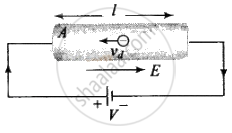Advertisements
Advertisements
प्रश्न
Which of the following characteristics of electrons determines the current in a conductor?
पर्याय
Drift velocity alone
Thermal velocity alone
Both drift velocity and thermal velocity
Neither drift nor thermal velocity
उत्तर
Drift velocity alone
Explanation:
Drift velocity is the average uniform velocity acquired by free electrons inside a metal by the application of an electric field which is responsible for the current through it

The direction of drift velocity for electron in a metal is opposite to that of applied electric field (i.e. current density `vecJ`).
`V_d oo E`, i.e. greater the electric field, larger will be the drift velocity.
The relationship between current and drift speed is given by I = ne Avd
Here, l is the current and vd is this drift velocity.
So, `I oo v_d`
Thus, only drift velocity determines the current in a conductor.
Important point: Remember direction of drift velocity and current is opposite, so we are taking the magnitude of drift velocity or drift speed of free electrons.
APPEARS IN
संबंधित प्रश्न
One of your friends says that he has read in the previous chapters that there can be no electric field inside a conductor. Consequently, there can be no current through it. What is the fallacy of this argument?
A fan with copper winding in its motor consumes less power compared to a similar fan with aluminium winding. Explain.
The amount of charge that passes in time t through a cross-section of a wire is
Q(t) = At2 + Bt + C.
(a) Write the dimensional formulae for A, B and C.
(b) If the numerical values of A, B and C are 5, 3 and 1, respectively, in S.I units, find the value of the current at t = 5 s.
Ten identical cells connected in series are needed to heat a wire of length one meter and radius ‘r’ by 10ºC in time ‘t’. How many cells will be required to heat the wire of length two meter of the same radius by the same temperature in time ‘t’?
A hank of uninsulated wire consisting of seven and a half turns is stretched between two nails hammered into a board to which the ends of the wire are fixed. The resistance of the circuit between the nails is determined with the help of electrical measuring instruments. Determine the proportion in which the resistance will change if the wire is unwound so that the ends remain to be fixed to the nails.
Assertion: When current through a bulb decreases by 0.5%, the glow of bulb decreases by 1%.
Reason: Glow (Power) which is directly proportional to square of current.
